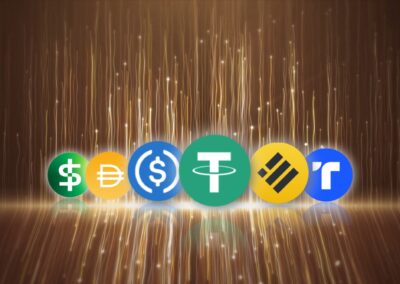Ensuring Price Stability for Virtual Transactions
The Rise of Stablecoins in the Digital Economy
Stablecoins are digital assets pegged to a stable asset, such as a fiat currency or a commodity, ensuring their value remains relatively constant over time. Unlike traditional cryptocurrencies like Bitcoin or Ethereum, which are known for their price volatility, stablecoins offer a more predictable and secure medium of exchange. This predictability is particularly important in the metaverse, where users and businesses engage in transactions involving virtual real estate, digital goods, and services.
For business executives, mid-level managers, and entrepreneurs in regions like Saudi Arabia, UAE, Riyadh, and Dubai, understanding the role of stablecoins in the metaverse is critical. These regions are at the forefront of embracing modern technology and blockchain innovations, and stablecoins provide a reliable tool for facilitating transactions and driving economic growth in virtual environments.
How Stablecoins Differ from Other Virtual Currencies
Stablecoins stand apart from other virtual currencies due to their unique mechanism for maintaining price stability. Traditional cryptocurrencies are often subject to significant price fluctuations, which can be attributed to market speculation, regulatory news, and macroeconomic factors. This volatility poses a challenge for their use as a stable medium of exchange, particularly in business contexts where price predictability is essential.
Stablecoins address this issue by being pegged to stable assets. For example, Tether (USDT) is pegged to the US dollar, meaning one USDT is always equivalent to one dollar. This pegging mechanism can be implemented in several ways: fiat-collateralized stablecoins are backed by reserves of fiat currency; crypto-collateralized stablecoins are backed by other cryptocurrencies but over-collateralized to absorb price volatility; and algorithmic stablecoins use smart contracts to adjust supply based on demand, maintaining their peg.
In the metaverse, the use of stablecoins ensures that transactions for virtual goods and services are not adversely affected by market volatility. This is particularly beneficial for businesses in the UAE and Saudi Arabia, where economic stability and trust in digital transactions are paramount. By adopting stablecoins, businesses can offer a more secure and predictable pricing model for their virtual offerings, enhancing user trust and engagement.
Benefits of Using Stablecoins in the Metaverse
The integration of stablecoins in the metaverse brings several benefits, making them a preferred choice for transactions. One of the primary advantages is the elimination of price volatility. Users can confidently engage in transactions, knowing that the value of the stablecoins they use will not fluctuate unpredictably. This stability is crucial for businesses planning long-term investments in virtual real estate, digital art, and other virtual assets.
Another significant benefit is the ease of cross-border transactions. Traditional banking systems often involve lengthy processes and high fees for international transfers. Stablecoins, on the other hand, facilitate instant and low-cost cross-border transactions. For regions like Riyadh and Dubai, which are hubs of international business and trade, this capability enhances the efficiency and cost-effectiveness of engaging in the global digital economy.
Moreover, stablecoins contribute to financial inclusion by providing a digital alternative to traditional banking. In the metaverse, users who might not have access to conventional financial services can participate in the digital economy using stablecoins. This inclusivity is particularly relevant in regions with a high penetration of mobile and internet technologies but limited access to traditional banking infrastructure.
Strategic Implications for Businesses and Entrepreneurs
Adopting Stablecoins for Business Success
For businesses operating in the metaverse, adopting stablecoins can be a strategic move to enhance transaction efficiency and customer trust. By offering stablecoin payment options, businesses can cater to a broader audience, including those who are wary of the volatility associated with other cryptocurrencies. This can lead to increased sales and customer satisfaction, driving business success in the virtual world.
For instance, a virtual real estate developer in Dubai can use stablecoins to sell properties within the metaverse. This approach not only ensures price stability but also simplifies the transaction process for international buyers. By eliminating the uncertainties associated with currency exchange rates and market fluctuations, stablecoins make it easier for buyers to invest in virtual assets with confidence.
Additionally, businesses can leverage stablecoins for microtransactions within the metaverse. In virtual environments where users frequently purchase small items, such as digital clothing or accessories, stablecoins offer a seamless and stable payment method. This enhances the user experience and encourages more frequent transactions, contributing to a thriving virtual economy.
Overcoming Challenges with Stablecoin Integration
While stablecoins offer numerous benefits, their integration into the metaverse also presents challenges that businesses need to address. One of the primary challenges is regulatory compliance. Different countries have varying regulations regarding the use of digital currencies, and businesses must navigate these legal landscapes to ensure compliance. In regions like Saudi Arabia and UAE, where regulatory frameworks are evolving, staying informed and compliant is essential.
Another challenge is the technological infrastructure required to support stablecoin transactions. Businesses need to invest in secure and scalable blockchain solutions to facilitate stablecoin payments. This involves partnering with technology providers and ensuring that the necessary cybersecurity measures are in place to protect transactions and user data.
Moreover, businesses must educate their customers about the benefits and usage of stablecoins. While stablecoins are gaining popularity, there is still a need for widespread awareness and understanding. Businesses can conduct educational campaigns and provide resources to help users navigate the world of stablecoins, enhancing their confidence and willingness to engage in digital transactions.
Conclusion: Embracing Stablecoins for a Secure Metaverse
The role of stablecoins in the metaverse is pivotal in ensuring price stability and fostering trust in virtual transactions. For businesses and entrepreneurs in Saudi Arabia, UAE, Riyadh, and Dubai, adopting stablecoins offers a strategic advantage in navigating the digital economy. By providing a stable and predictable medium of exchange, stablecoins enhance user engagement, facilitate cross-border transactions, and contribute to financial inclusion.
As the metaverse continues to evolve, businesses must stay ahead of technological trends and regulatory developments to leverage the full potential of stablecoins. By overcoming challenges and educating users, businesses can create a secure and thriving virtual environment, driving innovation and economic growth in the digital age.
#Stablecoins #Metaverse #VirtualCurrencies #PriceStability #DigitalEconomy #Blockchain #Cryptocurrency #BusinessSuccess #SaudiArabia #UAE #Riyadh #Dubai























